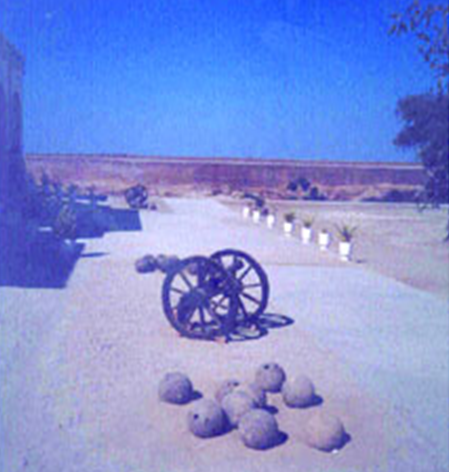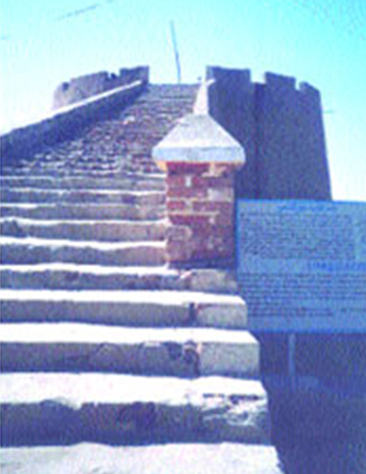Umerkot, Sindh
This is a collection of articles archived for the excellence of their content. Readers will be able to edit existing articles and post new articles directly |
Umerkot, Sindh
From Umerkot with love
By Nadeem Akram
Umerkot has much to offer in terms of history, culture and glory; but sadly there’s not enough official support to keep the historic city intact
SINDH has been eluding me for quite a while now. My previous visits to Sindh remained restricted to Karachi and Hyderabad despite my best efforts to explore the real Sindh. The jinx was finally broken this winter and I found myself, at half-past six in the morning, sitting in back of a car all set for Umerkot. Our journey started with the driver taking off on a rather deserted Drigh Road. My friends were as grouchy as I was for being up so early in the morning and it took us no more than 10 minutes to finish exchanging our morning pleasantries and another two minutes for our heads to drop back and falling asleep as the car sped towards the National Highway. I don’t know about the rest but I woke up as we were just entering Hyderabad!
Our driver skirted the main city of Hyderabad and soon we found ourselves travelling on rather busy road flanked by what once used to be a paved canal. The canal was rather shallow owing to the winter loadshedding of water and looked more like a sewer with filth flowing right under our noses. The scenery on our left was even worse. There was cow manure everywhere and the stench of animal dung impregnated with sewage fumes was unbearable. There was a silent tug of war going on between myself and my companion in the back seat. I cannot stand heat, therefore the temperature had to be on the chilly side; he on the other hand, being a hard core Islamabadi, believes in maintaining a temperature which is more close to the outside temperature. So that little battle of temperatures went on quite unnoticed by our third companion sitting in the front seat.
Soon the agony of staring at the decadence, which has become the hallmark of our urban dwellings, was over as we took a left turn on a rather busy intersection bursting with the onslaught of traffic converging from all directions. Slowly and carefully our driver got us out the unruly quagmire and we found ourselves racing towards Mirpur Khas. The change in scenery was dramatic. The road it seemed was engulfed in a sea of mango trees. There were trees all around. It was one of the most wonderful sights I have ever seen. Row after row of mango trees stood there silently without a whisper and watched humanity go past them in a humble yet dignified manner.
We reached Mirpur Khas at about half-past ten and decided to take a break. Our driver sped past the majestic government houses, government offices and rest houses which still exude the desired effect of awe and fear amongst the ordinary folks. The nomenclature may have changed to make it more user-friendly, but the way the system works is no different than what it used to be a hundred years ago. I was still debating the merits and demerits of the colonial system that we still hold so dear to us when our driver halted right next to an extremely neat yet an older looking building which on closer examination turned out to be a Municipal Musafir Khana (travellers’ inn) built by the so-called oppressors some hundred years ago. Apparently this was built for the benefit of weary travellers making a break journey at Mirpur Khas. The concept was neither foreign nor original; our western rulers simply followed the footsteps of our Central Asian rulers and took it one step further.
After a short break at Mirpur Khas we moved on. The city of Mirpur Khas is nothing but a giant construction site, like the rest of the country. Mirpur Khas marked the end of the mango country and the beginning of the rural Sindh that provides the much needed wheat, sugarcane, and vegetables. The countryside is flat, mostly barren, and sparsely populated. It is mind bogging to note that there are acres after acres on either side of the road which is under cultivation and then there are long patches of virgin land. There was no satisfactory explanation give by our host in Umerkot for this situation other than availability of water.
Half way through Umerkot, I could not help notice a solitary national flag fluttering violently in the afternoon sun. It was in the middle of nowhere with any official building in sight save a goth (village) in the background. Curiosity got the better of me and I coaxed my companions into indulging, and indulged we did! About three quarters of a kilometre from the road leading to Umerkot stood a small hut no bigger than a bedroom boasting a Pakistani flag which defiantly fluttered in the desert winds. Our driver took us as close to the building as he could and we walked the rest of the way. To our surprise we were greeted by a Sindhi teacher of Balochi persuasion and the hut was jam-packed with over 30 students of the adjoining goth studying under the tutelage of the Mr Ghulam Ali, the teacher.
It was an inspiring story. The teacher had, with his personal initiative and of course with the help of the community, built this hut some 12 years ago and since then he has been imparting primary education to 35 students every year. Several of his students have gone on to attend high school and some of them made it to college. He has had little or no support from the Sindh Education Department and all these years he has managed to operate this school with the help of village elders. My eyes welled up as he concluded his narration duly supported by a village elder that conveniently appeared and joined us. All my preconceived ideas about patriotism, bureaucratic inefficiencies, and the lack of civic will were taking breathing their last in the puddle next to the school as we bade farewell to the teacher, the students and the benefactor.
Umerkot greeted us with summery warmth. Whilst most of the country was cloaked in the wintry mist, Umerkot glowed with an inner amiability that is customary of little towns like Umerkot which are on a rebound course. Once the hub of southern Sindh, Umerkot lost its centrality owing to the restructuring that came about with the placement of foreign rulers. Once being revered as the place of birth of one of the most accomplished heads of state, Akbar the great, Umerkot was relegated to a principality of modern Sindh. And it was only recently that Umerkot was awarded the status that it rightly deserved -- that of an independent district.
Umerkot, like its compatriot Dipalupur in central Punjab, has much to offer in terms of history, culture and glory; but sadly has gone unnoticed by modern historians. It has not always been Umerkot. The history books tell us of a fort by the name of Amerkot which welcomed the floating king of India, Hummayun, who was trying to preserve his father’s legacy in India. It was at Amerkot that Hummayun, after a long and treacherous battle of deceit, managed to get the Hindu Rana of Amerkot to provide him and his thirsty troops respite and it was at Amerkot that his wife Hameeda Bano gave birth to Akbar the Great. It is interesting to note that Akbar’s birth place is quite far from the fort. It is therefore logical to assume that the Rana gave Hummayun safe passage and access to water more than anything else. The government of Sindh has put up an excuse of a monument at the birth site of one of the most illustrious emperors of all time, which looks pedestrian once you compare it with some of the monuments built at city intersections in Islamabad, Karachi and Lahore. But then who cares about a dead Sultan? The king is dead, long live the king!
Amerkot’s transformation to Umerkot is yet another story. A love story; and like all other love stories this has a happy ending. It is believed that a Muslim ruler of Amerkot by the name of Umer fell in love with a Sindhi nymph by the name of Marvi. The prince, unlike his predecessors, was a man of his word. He promised Marvi that unless she accepted him with her free will she would remain her captive but not her slave. Marvi resisted till the end, and eventually earned her freedom, unscathed. Umerkot owes its inception to the heroics of one woman who believed in free will.
The story might as well be a fairly tale, but the fact remains that Akbar’s Amerkot became Umerkot and so be it. I ventured into the fort. A magnificent structure by any standard, yet it is backed by little governmental assistance and has no local help. The fort is coming apart and yet there is hardly any effort to keep it intact
The fort is an amazing place. There is a museum in the middle of the fort being managed by personnel not as bright as bulb. We took a brief round of the Umerkot museum and were astonished to find the original works of Akbar in the form of Ain-i-Akbari, and many more of original works donated by the influentials of Sindh.
We bade our farewells to our host at the fort gate and headed for our next destination, no surprises there, Hyderabad.

